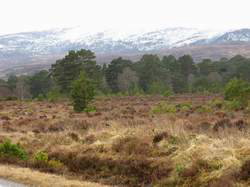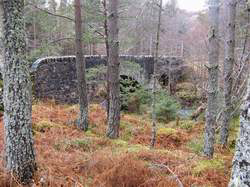Abandoned Communities ..... Strathcarron
88 people lived in Glencalvie, including four tenants. They lived in nineteen cottages, one built of stone, the rest of turf, with roofs made of heather. Three of the cottages were occupied by elderly single women, who paid no rent and were allowed to support themselves by grazing a few sheep or goats. However, the total rent of £55 10s was paid regularly, and no demands were made on the landowner for the support of sick or elderly people. The rent, very large for the size and quality of the estate, was raised by the people by growing barley, oats, and potatoes, and herding cattle and sheep.
One of the four tenants lived elsewhere. The other three, David Ross and his son David, and Alexander Ross, responded to the advert in the Inverness Courier by consulting the local minister, a young man by the name of Gustavus Aird. Aird wrote to Gillanders on behalf of the tenants. In his letter he stated that he had been assured by Major Charles Robertson, son of the laird, that he would not turn the people out if they continued to pay their rent, and he conveyed a promise that they would pay more rent, matching any offer that might come from elsewhere.
Gillanders replied to Aird on 21 March, apparently accepting his proposals. However, within a few days he had authorised the Sheriff of Ross and Cromarty to deliver writs of removal to the four tenants. The tenants were to be ordered to “flit and remove themselves, bairns, family, servants, subtenants, cottars and dependants, cattles, goods, and gear” so that “the Pursuer or others in his name may then enter thereto and peaceably possess, occupy and enjoy the same in time coming.”
The Sheriff and his staff made two attempts to deliver the writs of removal. On the first occasion, officers were met by a group of women at a bridge just outside the Glencalvie estate. The women asked for the removal writs, and then threw them on a fire recently prepared for that purpose. At this point the officers departed.
On the following Monday a larger group of officials and constables travelled up the valley. This time a much bigger crowd, said to be about 200 people with a majority of women, had gathered. It must have included people from other estates who had come to give support. According to one account some women seized the hand of the officer with the writs, and while some of them held the hand out by the wrist others put a live coal to the papers and set them alight. Again, the officers, led by Mr Cameron, the Sheriff-Substitute, decided to withdraw.
For a full account of these and later events in Strathcarron read John Prebble, The Highland Clearances, chapter 5.
No further action was taken until 1845. In the meantime people throughout Scotland had deserted the established church in the movement know as the Disruption of the Church of Scotland. Gustavus Aird was one of the ministers who joined the Free Church. He had to leave the local church, at Croick, but attracted large congregations to his services and sermons on a hillside.
Early in 1845 it became clear that James Gillanders intended to make another attempt to clear Glencalvie. The Times took a close interest in the plight of the people of the estate, and sent a correspondent to Ardgay to cover the subsequent events.
You may be able to read The Times on microfilm in your local library.
A very long article appeared in The Times on 20 May. It gave a detailed description of Glencalvie and the surrounding district, and it talked of the Highlanders as imaginative people, poetic from dwelling amidst wild and romantic scenery, shut out from the world, and clinging to the traditions of the past.
The article reported that in 1844 the four tenants had been tricked into meeting Gillanders in the town of Tain, when notices of possession had been served on them. Originally they had been required to leave by 12 May, but the deadline had been extended to 25 May. For some time the people of Glencalvie had been searching for accommodation elsewhere, but only six out of 18 households had found a place, and in most cases it was highly unsatisfactory. A father and son, presumably the two David Rosses mentioned earlier, had found a “piece of black moor” near Tain, without any house or shed on it, from which they hoped to obtain sustenance. Another old man with a family had got a house and a small plot of land in Edderton, 20 miles away. An old pensioner had obtained two rooms for himself and his family, and for his son’s family, but without any land or means of sustenance attached to it. A widow with four children, two imbecile, had obtained two small apartments in a bothie near Bonar Bridge, but again without land or means of sustenance. A man with a wife and four children had an apartment at Bonar Bridge, but would be quite destitute. The remaining 12 households would be “hopeless and helpless”.
One of the four tenants lived elsewhere. The other three, David Ross and his son David, and Alexander Ross, responded to the advert in the Inverness Courier by consulting the local minister, a young man by the name of Gustavus Aird. Aird wrote to Gillanders on behalf of the tenants. In his letter he stated that he had been assured by Major Charles Robertson, son of the laird, that he would not turn the people out if they continued to pay their rent, and he conveyed a promise that they would pay more rent, matching any offer that might come from elsewhere.
Gillanders replied to Aird on 21 March, apparently accepting his proposals. However, within a few days he had authorised the Sheriff of Ross and Cromarty to deliver writs of removal to the four tenants. The tenants were to be ordered to “flit and remove themselves, bairns, family, servants, subtenants, cottars and dependants, cattles, goods, and gear” so that “the Pursuer or others in his name may then enter thereto and peaceably possess, occupy and enjoy the same in time coming.”
The Sheriff and his staff made two attempts to deliver the writs of removal. On the first occasion, officers were met by a group of women at a bridge just outside the Glencalvie estate. The women asked for the removal writs, and then threw them on a fire recently prepared for that purpose. At this point the officers departed.
On the following Monday a larger group of officials and constables travelled up the valley. This time a much bigger crowd, said to be about 200 people with a majority of women, had gathered. It must have included people from other estates who had come to give support. According to one account some women seized the hand of the officer with the writs, and while some of them held the hand out by the wrist others put a live coal to the papers and set them alight. Again, the officers, led by Mr Cameron, the Sheriff-
For a full account of these and later events in Strathcarron read John Prebble, The Highland Clearances, chapter 5.
No further action was taken until 1845. In the meantime people throughout Scotland had deserted the established church in the movement know as the Disruption of the Church of Scotland. Gustavus Aird was one of the ministers who joined the Free Church. He had to leave the local church, at Croick, but attracted large congregations to his services and sermons on a hillside.
Early in 1845 it became clear that James Gillanders intended to make another attempt to clear Glencalvie. The Times took a close interest in the plight of the people of the estate, and sent a correspondent to Ardgay to cover the subsequent events.
You may be able to read The Times on microfilm in your local library.
A very long article appeared in The Times on 20 May. It gave a detailed description of Glencalvie and the surrounding district, and it talked of the Highlanders as imaginative people, poetic from dwelling amidst wild and romantic scenery, shut out from the world, and clinging to the traditions of the past.
The article reported that in 1844 the four tenants had been tricked into meeting Gillanders in the town of Tain, when notices of possession had been served on them. Originally they had been required to leave by 12 May, but the deadline had been extended to 25 May. For some time the people of Glencalvie had been searching for accommodation elsewhere, but only six out of 18 households had found a place, and in most cases it was highly unsatisfactory. A father and son, presumably the two David Rosses mentioned earlier, had found a “piece of black moor” near Tain, without any house or shed on it, from which they hoped to obtain sustenance. Another old man with a family had got a house and a small plot of land in Edderton, 20 miles away. An old pensioner had obtained two rooms for himself and his family, and for his son’s family, but without any land or means of sustenance attached to it. A widow with four children, two imbecile, had obtained two small apartments in a bothie near Bonar Bridge, but again without land or means of sustenance. A man with a wife and four children had an apartment at Bonar Bridge, but would be quite destitute. The remaining 12 households would be “hopeless and helpless”.
Two
Glencalvie
Bridge over the River Carron

